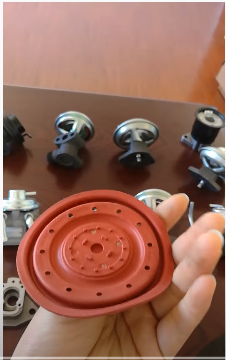This video shows how to test all electronic EGR systems. This video focuses on the 5-wire Linear EGR Valve used on many GM cars. It has a 3100-cc engine. (3.1L) and the engine has a reputation for clogging EGR passages in its intake manifold. These electronic EGR valves can be used in either the closed or open position.
The EGR Vale, also known as the exhaust gas recirculation (or EGR) valve, is an emissions control device that is primarily designed to reduce nitrogen oxide pollution. Properly in the engine’s combustion room, you can reduce nitrogen oxide. At temperatures higher than 2500 degrees Fahrenheit, nitrogen oxide will form. Because the exhaust gases help lower the temperature of the fuel/air mixture, the EGR valve helps to recirculate some of this nitrogen dioxide pollution back into the engine’s combustion chamber.
The EGR system allows the recirculation of small amounts of exhaust gases that would otherwise have found their way into the public airstream. Inert gas is also known as exhaust gas. These are gases that have been burnt and cannot be returned. The exhaust gases recirculated into an intake manifold need to be controlled and precise. The engine could stall or perform poorly if it is not appropriately handled. We will discuss in detail how to test EGR levels.
EGR Valve Testing Procedure

Here’s how to inspect the EGR system after the visual inspection:
- Place the hood on the vehicle and lock it in place.
- Disengage the vacuum line from the EGR valve.
- Attach a vacuum pump to the EGR.
- Keep applying the vacuum until you see the EGR valve open. The engine will start to idle or even stall as the valve opens. If the EGR valve opens, the engine will begin to idle. When the vacuum is removed from the valve, the valve will stop.
The exhaust pipes that run from the intake manifold to the exhaust traverse are reasonable and allow exhaust gas recirculation. When the valve is closed, it fits tightly. If the EGR valve does not open when you apply vacuum to it, the valve may be defective and should be replaced. Use a vacuum gauge
- Start with a cold engine.
- Remove the vacuum component from the EGR valve, and install a tee.
- Re-plug vacuum line from EGR valve
- Check the gauge by starting the engine. The reading should read zero.
- Increase the engine RPM until it reaches 2000. The reading should not change from zero.
- Let the engine heat up to its average operating temperature
- You can accelerate the engine to 2000 RPM once more. The gauge reading should range between 1 and 4.
If this reading is zero, it means that the CTO switch has not been working correctly.
Manually Testing the Valve Stem
The metal disc of the valve houses a spring, diaphragm, and plunger that keep it closed. A vacuum pull on the diaphragm can open the valve, overcoming spring pressure.
You may be able to see tiny openings under the metal disc if you have access to the valve. If you can reach the EGR valve openings, push the diaphragm with your finger.
If the diaphragm isn’t moving at all when you apply finger pressure to it, check the EGR valve passages for carbon deposits. The deposits might be restricting plunger movement (see the section EGR Valve System Passages Cleaning below); otherwise, the mechanism may have failed.
Testing EGR Valve Diaphragm Condition

Like any other machine, valve diaphragms are subject to wear and tear. They may eventually leak exhaust gases. To determine the condition of the diaphragm, which is hidden within the valve case, you will need to perform a specific and straightforward test. Use the parking brake to stop the wheels from moving and start the engine.
Use the thin straw to insert into the tip of a carburetor cleaner and spray a small amount of cleaner towards the diaphragm. If your engine’s rpm rises when you spray carburetor cleaner in the valve, the diaphragm has likely sprung a leak, and you should replace it.
Stem Movement Testing
Turn the engine on and leave it running for approximately 15 minutes. Keep the engine running at idle speed. Push the accelerator linkage quickly by hand or have an assistant do it for you. As you engage this, pay attention to the valve diaphragm’s movement. If necessary, use a small mirror to help you see the valve diaphragm movement.
If the stem/diaphragm isn’t moving, disconnect the vacuum hose at the top of your valve. Your finger should be on the opening of the vacuum hose that you have just disconnected.
As in the previous step, increase engine rpm once again. Depending on which system you have, you may feel a vacuum or slight pressure at your fingertip.
You may not feel any change in pressure or vacuum if this is the circuit’s fault. Connect the vacuum hose to your valve.
Operation of a Vacuum Pump
When the engine is at its optimum temperature, remove the vacuum hose and plug it in using a thin Phillips head screwdriver or another similar tool.
Attach a hand vacuum pump to your EGR valve and apply a 15 in-Hg vacuum to it. You can borrow one at a local auto parts shop if you don’t own a vacuum pump. Add vacuum to the valve and check for diaphragm movement. Pay attention to the engine idle, empty the machine, and the idle should become rough.
If the valve isn’t moving or the plunger won’t move, replace the valve. If the engine idle operation is not affected, but the plunger does move, and the diaphragm holds vacuum, then carbon buildup may be affecting the EGR system or valve. Follow the following section to clean and remove the valve.
Signs that your EGR is not working properly
Rough Idling
The EGR valve will become stuck-open if it doesn’t close after exhaust gas has passed through the intake manifold. This opening can produce a rough sound that feels like someone with a raw sore throat.
Poor Fuel Economy
This one is more subtle and harder for people to notice. However, if significant fuel economy issues are present, you could predict that the EGR Valve will end or have already failed.
Acceleration Power is Low
Another sign that your EGR valve may be clogged or malfunctioning is the loss of acceleration power. Your vehicle’s air-to-fuel ratio will change powerfully. Check engine light on
You will need to plug in a scanner tool to the OBDII port to diagnose the reason behind the check engine lights accurately. Bluetooth is an option for most vehicles. Amazon.com sells a scanner for $50 if you don’t own one. You will need to search for P0401, which indicates that the exhaust gas recirculation system is not working correctly or is reducing flow.
Components Connected to the EGR
The EGR valve is associated with many interconnected devices. These include many sensors, manifolds, and vacuums.
1. Vacuum
The intake manifold vacuum is located under the throttle plates of the carburetor, accelerated by the piston’s pumping. Venturi vacuum is also present. It comes from the hole in the venturi.
2. Vacuum amplifier
Another device that controls the EGR valve is the vacuum amplifier. The vacuum amplifier uses the intake manifold vacuum to receive a signal from your carburetor, which is why you might experience a rough idle. This phenomenon is often caused by the vacuum amplifier not receiving the correct signal from the carburetor venturi. The venturi tells the vacuum amplifier how much manifold vacuum it should deliver to the EGR. The manifold vacuum that reaches the EGR valve is too high, opening the valve wider and allowing more exhaust gas to circulate idle.
3. Backpressure sensor for the exhaust

This sensor is sometimes called a transducer. It consists of two distinct parts: the sensor and the spacer. The spacer contains a tube that senses exhaust backpressure. The sensor uses the backpressure to indicate how much to use in the EGR valve to the vacuum and helps to improve fuel economy and driveability. If you experience a loss of acceleration or poor fuel mileage, it could be an issue with the exhaust back pressure sensor.
4. Override switch for coolant temperature
The CTO switch is located on an intake manifold. It is responsible for sensing coolant and stopping the vacuum signal from reaching the EGR valve before the coolant temperature has reached a certain point. It prevents the EGR from starting before the coolant has had time to warm up, resulting in better vehicle performance when the temperature outside is cold.
5. EGR Delay Timer
The delay timer prevents exhaust gas recirculation for short periods after the engine has been started. The vacuum solenoid powers the engine when the ignition is turned on. After that, the vacuum is cut off from the amplifier. The EGR timer control dis-powers the vacuum solenoid after half an hour of starting the engine. Normal exhaust gas recirculation starts.
A visual inspection is essential to ensure that the EGR system is working correctly. The service manual that came with your vehicle can perform a visual inspection. Although we attempted to provide information about all components of the EGR system as much as possible, parts specific to your car may not be listed. The manual will include a diagram of the vacuum circuit. Make sure all hoses are routed correctly according to this diagram. Also, ensure no cracks or loose connections between vacuum hoses.
6. GSC International 4-2061 Vacuum Pump
To test the EGR valve, you will need a vacuum pump. Although there are many similar models, this one is the best. It is manufactured by GSC international, and it is very affordable to buy. The hose pump plugs directly into the EGR valve and is operated by hand. The air will displace as you push the trigger, knowing if your EGR valve is performing. Both methods will work.
See reviews and pricing for GSC International 4-2061 at Amazon.com.
What Does the EGR System Do?

Your vehicle’s EGR system uses the EGR valve to inject measured amounts of the exhaust gas back into the combustion chambers. These gases reduce combustion temperatures. Lower combustion temperatures equal lower emissions of harmful NOx (oxides nitrogen) gases.
Exhaust gases should not flow continuously into the combustion chambers. As the engine reaches operating temperature, the gases will flow slowly as engine speed increases. This flow pattern can cause engine performance to drop. The design can happen, for example, if the EGR valve is not closing completely when the engine idles or if it fails to open as the engine speeds increase.
Problems in the EGR system or valve will eventually occur. Small carbon particles in exhaust gases can stick to the passageways of the EGR and intake systems, clogging pipes, exhaust gasses channels, and the EGR valve. This series of events will cause the valve’s plunger mechanism to become damaged, and it may not open or close properly. EGR components and parts wear out, and the valve’s function stops working correctly.
Troubleshooting is necessary for the components to function appropriately. It is essential to determine if the EGR valve is defective or if carbon deposits have begun to disrupt EGR system operation and engine operation.
Conclusion
We have provided two methods to test the EGR valve. For any inquiries, please let us know. If your truck or car is experiencing symptoms, you should pay attention to them and consult your service manual to determine the installed system and components. Proper maintenance of the exhaust gas recirculation device is essential. It will reduce air pollution and improve your vehicle’s driveability.

